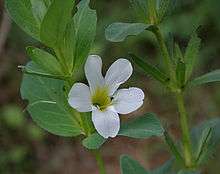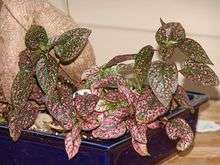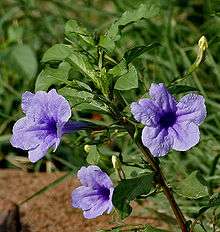Acanthaceae
| Acanthaceae | |
|---|---|
 | |
| Flowers of Odontonema cuspidatum | |
| Scientific classification | |
| Kingdom: | Plantae |
| (unranked): | Angiosperms |
| (unranked): | Eudicots |
| (unranked): | Asterids |
| Order: | Lamiales |
| Family: | Acanthaceae Juss.[1][2] |
| Type genus | |
| Acanthus L. | |
| Subfamilies | |
|
Acanthoideae | |
| Synonyms | |
|
Avicenniaceae Miq., nom. cons.
Justiciaceae Raf. | |
Acanthaceae is a family (the acanthus family) of dicotyledonous flowering plants containing almost 250 genera and about 2500 species. Most are tropical herbs, shrubs, or twining vines; some are epiphytes. Only a few species are distributed in temperate regions. The four main centres of distribution are Indonesia and Malaysia, Africa, Brazil, and Central America. The representatives of the family can be found in nearly every habitat, including dense or open forests, scrublands, wet fields and valleys, sea coast and marine areas, swamps, and mangrove forests.
Description
Plants in this family have simple, opposite, decussated leaves with entire (or sometimes toothed, lobed, or spiny) margins, and without stipules. The leaves may contain cystoliths, calcium carbonate concretions, seen as streaks on the surface.
The flowers are perfect, zygomorphic to nearly actinomorphic, and arranged in an inflorescence that is either a spike, raceme, or cyme. Typically, a colorful bract subtends each flower; in some species, the bract is large and showy. The calyx usually has four or five lobes; the corolla tubular, two-lipped or five-lobed; stamens number either two or four, arranged in pairs and inserted on the corolla, and the ovary is superior and bicarpellated, with axile placentation.
The fruit is a two-celled capsule, dehiscing somewhat explosively. In most species, the seeds are attached to a small, hooked stalk (a modified funiculus called a jaculator or a retinaculum) that ejects them from the capsule.
A species well-known to temperate gardeners is bear's breeches (Acanthus mollis ), a herbaceous perennial plant with big leaves and flower spikes up to 2 m tall. Tropical genera familiar to gardeners include Thunbergia and Justicia.
Avicennia, a genus of mangrove trees, usually placed in Verbenaceae or in its own family, Avicenniaceae, is included in Acanthaceae by the Angiosperm Phylogeny Group on the basis of molecular phylogenetic studies that show it to be associated with this family.
Medicinal uses
Traditionally the most important part use in Acanthaceae is the leaves and they are used externally for wounds. Some research has indicated that Acanthaceae possess antifungal, cytotoxic, anti-inflammatory, anti-pyretic, antioxidant, insecticidal, hepatoprotective, immunomodulatory, anti- platelet aggregation and anti-viral potential.[3]
Phytochemistry
Phytochemical reports on family Acanthaceae are glycosides, flavonoids, benzonoids, phenolic compounds, naphthoquinone and triterpenoids.[3]
Selected genera






The 246 accepted genera, according to Germplasm Resources Information Network,are:
- Acanthopale C.B.Clarke
- Acanthopsis Harv.
- Acanthostelma Bidgood & Brummitt
- Acanthura Lindau
- Acanthus L. (bear's breech)
- Achyrocalyx Benoist
- Aechmanthera
- Adhatoda Mill. (sometimes included in Justicia)
- Afrofittonia Lindau
- Ambongia Benoist
- Ancistranthus Lindau (desert honeysuckle)
- Ancistrostylis T.Yamaz.
- Andrographis Wall. ex Nees (false waterwillow)
- Angkalanthus Balf.f.
- Anisacanthus Nees
- Anisosepalum E.Hossain
- Anisostachya Nees (sometimes included in Justicia)
- Anisotes Nees
- Anomacanthus R.D.Good
- Apassalus Kobuski
- Aphanosperma T.F.Daniel
- Aphelandra R.Br.
- Aphelandrella Mildbr.
- Ascotheca Heine
- Asystasia Blume
- Asystasiella Lindau
- Avicennia L.
- Ballochia Balf.f.
- Barleria L. (bush violets)
- Barleriola Oerst
- Benoicanthus Heine & A.Raynal
- Blechum P.Browne
- Blepharis Juss.
- Borneacanthus Bremek.
- Boutonia DC.
- Brachystephanus Nees
- Bravaisia DC.
- Brillantaisia P.Beauv.
- Calacanthus T.Anderson ex Benth. & Hook.f.
- Calophanoides (C.B.Clarke) Ridl. (sometimes included in Justicia)
- Calycacanthus K.Schum.
- Camarotea Scott-Elliot
- Carlowrightia A.Gray (wrightwort)
- Celerina Benoist
- Cephalacanthus Lindau
- Chaetacanthus Nees
- Chalarothyrsus Lindau
- Chamaeranthemum Nees
- Championella Bremek.
- Chileranthemum Oerst.
- Chlamydacanthus Lindau (sometimes included in Theileamea)
- Chlamydocardia Lindau
- Chlamydostachya Mildbr.
- Chroesthes Benoist
- Clinacanthus Nees
- Clistax Mart.
- Codonacanthus Nees
- Conocalyx Benoist
- Corymbostachys Lindau
- Cosmianthemum Bremek.
- Crabbea Harv.
- Crossandra Salisb.
- Crossandrella C.B.Clarke
- Cyclacanthus S.Moore
- Cylindrosolenium Lindau
- Cyphacanthus Leonard
- Dactylostegium Nees (sometimes included in Dicliptera)
- Danguya Benoist
- Dasytropis Urb.
- Dichazothece Lindau
- Dicladanthera F.Muell.
- Dicliptera Juss. (Foldwing)
- Didyplosandra Wight ex Bremek.
- Dipteracanthus Nees (sometimes included in Ruellia)
- Dischistocalyx T.Anderson ex Benth. & Hook.f.
- Dolichostachys Benoist
- Drejera Nees
- Drejerella Lindau (sometimes included in Justicia)
- Duosperma Dayton
- Dyschoriste Nees (snakeherb)
- Ecbolium Kurz
- Echinacanthus Nees
- Elytraria Michx. (scalystem)
- Encephalosphaera Lindau
- Epiclastopelma Lindau
- Eranthemum L.
- Eremomastax Lindau
- Eusiphon Benoist (often included in Ruellia)
- Filetia Miq.
- Fittonia Coem.
- Forcipella Baill.
- Forsythiopsis Baker (sometimes included in Oplonia)
- Geissomeria Lindl.
- Glossochilus Nees
- Golaea Chiov.
- Graphandra J.B.Imlay
- Graptophyllum Nees
- Gymnophragma Lindau
- Gymnostachyum Nees
- Gynocraterium Bremek.
- Gypsacanthus E.J.Lott et al.
- Haplanthodes Kuntze
- Harpochilus Nees
- Hemiadelphis Nees
- Hemigraphis Nees (sometimes included in Strobilanthes)
- Henrya Nees
- Herpetacanthus Nees
- Heteradelphia Lindau
- Holographis Nees
- Hoverdenia Nees
- Hulemacanthus S.Moore
- Hygrophila R.Br. (swampweed)
- Hypoestes (including Periestes)
- Ionacanthus Benoist
- Isoglossa Oerst.
- Isotheca Turrill
- Jadunia Lindau
- Juruasia Lindau
- Justicia L. (justicia, water-willow, shrimp plant)
- Kalbreyeriella Lindau
- Kosmosiphon Lindau
- Kudoacanthus Hosok.
- Lankesteria Lindl.
- Lasiocladus Bojer ex Nees
- Leandriella Benoist
- Lepidagathis Willd.
- Leptostachya Nees
- Liberatia Rizzini (sometimes included in Lophostachys)
- Linariantha B.L.Burtt & R.M.Sm.
- Lophostachys Pohl
- Louteridium S.Watson
- Lychniothyrsus Lindau
- Marcania J.B.Imlay
- Megalochlamys Lindau
- Megalostoma Leonard
- Megaskepasma Lindau
- Melittacanthus S.Moore
- Mellera S.Moore
- Mendoncia Vand.
- Metarungia Baden
- Mexacanthus T.F.Daniel
- Meyenia Nees
- Mimulopsis Schweinf.
- Mirandea Rzed.
- Monechma Hochst. (sometimes included in Justicia)
- Monothecium Hochst.
- Morsacanthus Rizzini
- Nelsonia R.Br.
- Neohallia Hemsl.
- Neriacanthus Benth.
- Neuracanthus Nees
- Odontonema Nees (toothedthread)
- Ophiorrhiziphyllon Kurz
- Oplonia Raf.
- Oreacanthus Benth.
- Orophochilus Lindau
- Pachystachys Nees
- Pelecostemon Leonard
- Pentstemonacanthus Nees
- Perenideboles Ram. (Goyena)
- Pericalypta Benoist
- Peristrophe Nees
- Petalidium Nees
- Phaulopsis Willd.
- Phialacanthus Benth.
- Phidiasia Urb.
- Phlogacanthus Nees
- Physacanthus Benth.
- Podorungia Baill.
- Poikilacanthus Lindau
- Polylychnis Bremek. (often included in Ruellia)
- Populina Baill.
- Pranceacanthus Wassh.
- Pseuderanthemum Radlk.
- Pseudocalyx Radlk.
- Pseudodicliptera Benoist
- Pseudoruellia Benoist
- Psilanthele Lindau
- Ptyssiglottis T.Anderson
- Pulchranthus V.M.Baum et al.
- Pupilla Rizzini (sometimes included in Justicia)
- Razisea Oerst.
- Rhinacanthus Nees
- Rhombochlamys Lindau
- Ritonia Benoist
- Rostellularia Rchb. (sometimes included in Justicia)
- Ruellia L. (Wild Petunia)
- Ruelliopsis C.B.Clarke
- Rungia Nees
- Ruspolia Lindau
- Ruttya Harv.
- Saintpauliopsis Staner (sometimes included in Staurogyne)
- Salpinctium T.J.Edwards
- Salpixantha Hook.
- Samuelssonia Urb. & Ekman
- Sanchezia Ruiz & Pav.
- Santapaua N.P.Balakr. & Subr. (sometimes included in Hygrophila)
- Sapphoa Urb.
- Satanocrater Schweinf.
- Sautiera Decne.
- Schaueria Nees
- Schwabea Endl. & Fenzl
- Sclerochiton Harv.
- Sebastiano-schaueria Nees
- Sericospora Nees
- Siphonoglossa Oerst. (tubetongue)
- Spathacanthus Baill.
- Sphacanthus Benoist
- Sphinctacanthus Benth.
- Spirostigma Nees
- Standleyacanthus Leonard
- Staurogyne Wall.
- Steirosanchezia Lindau
- Stenandriopsis S.Moore
- Stenandrium Nees (shaggytuft)
- Stenostephanus Nees
- Streblacanthus Kuntze
- Streptosiphon Mildbr.
- Strobilanthes Blume
- Strobilanthopsis S.Moore
- Styasasia S.Moore
- Suessenguthia Merxm.
- Synchoriste Baill.
- Taeniandra Bremek.
- Tarphochlamys Bremek.
- Teliostachya Nees
- Tessmanniacanthus Mildbr.
- Tetramerium Nees
- Theileamea Baill.
- Thunbergia Retz.
- Thysanostigma J.B.Imlay
- Tremacanthus S.Moore
- Triaenanthus Nees
- Trichanthera Kunth
- Trichaulax Vollesen
- Trichocalyx Balf.f.
- Trichosanchezia Mildbr.
- Ulleria Bremek. (often included in Ruellia)
- Vavara Benoist
- Vindasia Benoist
- Warpuria Stapf
- Whitfieldia Hook.
- Xantheranthemum Lindau
- Xerothamnella C.T.White
- Yeatesia Small (Bractspike)
- Zygoruellia Baill.[4]
Excluded genera
- Thomandersia Baill. → Thomandersiaceae[5][6]
References
| Wikimedia Commons has media related to Acanthaceae. |
| Wikispecies has information related to: Acanthaceae |
- 1 2 3 "Family: Acanthaceae Juss., nom. cons.". Germplasm Resources Information Network. United States Department of Agriculture. 2003-01-17. Retrieved 2011-07-29.
- ↑ Angiosperm Phylogeny Group (2009). "An update of the Angiosperm Phylogeny Group classification for the orders and families of flowering plants: APG III" (PDF). Botanical Journal of the Linnean Society. 161 (2): 105–121. doi:10.1111/j.1095-8339.2009.00996.x. Retrieved 2013-07-06.
- 1 2 Awan, A.J., Aslam, M.S (2014). "FAMILY ACANTHACEAE AND GENUS APHELANDRA: ETHNOPHARMACOLOGICAL AND PHYTOCHEMICAL REVIEW.". International Journal of Pharmacy and Pharmaceutical Science. 6 (10): 44–55.
- ↑ "Acanthaceae". Integrated Taxonomic Information System. Retrieved 2011-07-29.
- ↑ Wortley, A.H., Harris, D.J. & Scotland, R.W.; Harris, D. J.; Scotland, R. W. (2007). "On the Taxonomy and Phylogenetic Position of Thomandersia.". Systematic Botany. 32 (2): 415–444. doi:10.1600/036364407781179716.
- ↑ "GRIN genera sometimes placed in Acanthaceae". Germplasm Resources Information Network. United States Department of Agriculture. Retrieved 2011-07-29.
- Schwarzbach, Andrea E.; McDade, Lucinda A. (2002). "Phylogenetic relationships of the mangrove family Avicenniaceae based on chloroplast and nuclear ribosomal DNA sequences". Systematic Botany. 27: 84–98.
External links
- Acanthaceae in L. Watson and M.J. Dallwitz (1992 onwards). The families of flowering plants: descriptions, illustrations, identification, information retrieval.
- Tree of Life Acanthaceae
- Family Acanthaceae Flowers in Israel.



_W_IMG_1973.jpg)